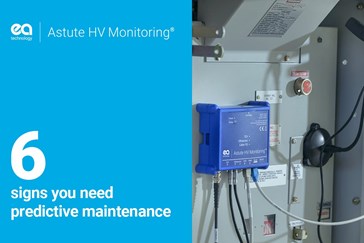6 signs you need predictive maintenance E-book
-
24 February 2021
-
David Russell
6 signs you need predictive maintenance

Predictive maintenance (PdM) – using equipment monitoring and data analysis tools and techniques to spot problems in processes and defects in equipment to predict when remedial work will be needed – isn’t a new concept. It’s all about minimising the risk of asset failure. If you’re thinking about the effectiveness of your maintenance regime, here are six signs you need predictive maintenance…
1. The number of unscheduled outages is escalating
Unplanned downtime is costly, whether in terms of lost production, disruption to consumers or safety issues in the case of a major incident. Reputational damage is a further factor to consider. If the number of unscheduled outages your network is experiencing is on the up, it’s likely that your current maintenance practices are falling down. Predictive maintenance allows you to identify and rectify problems in a planned and timely manner, minimising the risk of power cuts and catastrophic failure.
2. You need to reduce your maintenance costs
Perhaps you already have a preventive maintenance schedule in place, using periodic testing to assess the condition of your assets. As thorough as this may be, it involves employees making what may be unnecessary trips to assets, some of which may be remote. You also run the risk of unexpected equipment failure between surveys. It’s far more efficient to prioritise work schedules based on the assets that you already know need attention, basing your decisions on solid data delivered by sensors that measure ongoing equipment performance. A PdM strategy will offer long-term savings as you’ll be able to predict time to failure for individual assets and schedule repair work accordingly.
3. Asset reliability needs to be improved
Are you running your assets to failure? Reactive maintenance – waiting for problems to occur – means that you are simply firefighting (potentially literally!). Components are much more likely to fail if they aren’t part of a scheduled maintenance programme. While periodic checks are preferable to no checks, sadly equipment doesn’t fail according to a set timetable to suit you. PdM will allow you to monitor your assets, helping you spot trends and make informed decisions to ensure that your network becomes more efficient overall.
5. Partial Discharge is causing high-voltage asset failure
Partial Discharge (PD) is a problem – left unaddressed, the resulting damage to insulation can lead to the breakdown and failure of high-voltage assets. It’s estimated that PD damage contributes to 85% of disruptive failures in HV and MV equipment. Unfortunately, periodically surveying assets for PD individually can be a hit-and-miss affair, as the PD may not be present on the day of testing. Offline testing is disruptive and time-consuming, making online testing a much better – and safer – option. But again, timing is everything, making continuous monitoring a far sounder choice that can pay real dividends in the longterm.
6. You want to improve safety for maintenance personnel
The safety of your maintenance team is always paramount. The optimal identification of problems via a predictive maintenance system means that offline testing can be avoided. In the event of a power issue, an instant alert goes straight to the right people. From there, isolating the issue is straightforward, avoiding escalation and a potential domino effect on the rest of the network. Maintenance employees have a clear picture of what they’re dealing with before they repair the asset, meaning that they can be fully prepared with the correct components for the job for a safe repair in the minimum amount of time.
7. You need to reduce operating costs
Power disruptions are costly on a number of fronts, as already mentioned. And while preventive maintenance is certainly a step up from a reactive approach, it has its own pitfalls. Yes, a scheduled monitoring programme will help you keep on top of repairs, but it won’t allow the most efficient use of maintenance time as surveys can’t be guaranteed to coincide with problems. The initial outlay involved in setting up a predictive maintenance system is more than offset through the return on investment of streamlined operations via a more efficient maintenance programme, better forward planning and fewer outages.
Want to find out more about predictive maintenance? Download our eBook.
We’re here to help you. Contact us
+44 (0) 151 347 2313